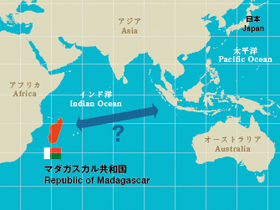Madagascar's
 Can you imagine that this island is larger than all of Japan? Or that the islanders, living near the African continent, speak a language that is related to the languages of Southeast Asia and Oceania?
Can you imagine that this island is larger than all of Japan? Or that the islanders, living near the African continent, speak a language that is related to the languages of Southeast Asia and Oceania?
Madagascar is situated in the ocean east of the African continent. The area doesn't look large, compared to the continent, but it is actually 590,000 km², i.e. 1.6 times larger than the whole area of Japan. Madagascar is the fourth largest island in the world (not considering Australia), next to Greenland, Papua New Guinea, and Kalimantan (Borneo).
The island separated from the African Continent or the Indian Subcontinent during the Mesozoic era, when there were supposedly no lemurs--and certainly no humans.
Nobody knows when humans first reached or settled this island. The oldest indications, pollens of secondary forest and artificial tools, have been dated to 2,000 years ago or more. We cannot be sure, however, that it was "settlers" who left these remains. A settlement is a place used for a long period, and the earliest known settlement is dated to about the 8th century A.D.
Those who left early remains, where did they come from? One clue to this problem is provided by the languages of the island. Malagasy, the main language spoken for more than a thousand years in Madagascar, belongs to the Austronesian family of languages, which is distributed throughout the islands of Southeast Asia and Oceania. In Africa, there are very few people who speak an Austronesian language, aside from Malay immigrants in South Africa. By contrast, Austronesian languages are dominant in the Indo-Pacific oceans, from Madagascar to Taiwan, Hawai’i, Easter Island, and New Zealand. Scholars have concluded that skillful navigators carried these languages across the oceans and that people reached Madagascar.